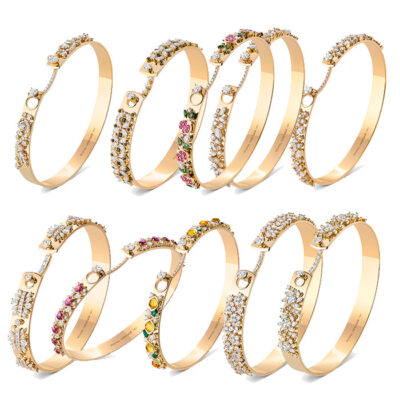Style
27 June 2017
Share
Feng. J, jeweler of the 21st century
After Shanghai, Feng. J is about to open a second showroom in Paris to present her high jewelry pieces. At just over 30, this Chinese designer has established herself as a major figure in jewelry.
The signature piece
This “Orchid” necklace is one of the 80 pieces produced each year for her in the Parisian workshops, and it’s the ultimate reference of Feng. J’s jewelry mastery. The focal point of the pendant is its unheated central sapphire of more than 11 carats, and its intense purple-blue color attracts like a magnet. This piece makes almost no reference to any other jewelry brand’s style from the past. Around it, an exceptionally rich strata of materials takes form: the voluptuousness of the flower is metaphorized by superimposed pistils and petals in carved jade, diamonds and titanium with an unheard-of lightness. From first glance, the level of technical prowess resounds with the power of the design. The tentacle-like petals bend gracefully to evoke the wings of a butterfly or a bird. In these pictures, the AlmaKarina duo creates an atmosphere that only further amplifies and sublimates the mysterious, almost disturbing power of the jewelry piece.
21st century high jewelry
Originating from a family of great art collectors and a long forgotten Chinese jewelry tradition, Feng. J invents the jewelry of the future. For those who seek minimalism, you won’t find it here… On the mutant orchids and hybrid birds there are no flat areas of color or metal, everything is worked in detail, set, intertwined, chiseled, or covered with stones. Each detail is mastered. Diamonds, jade, sapphires and rubies form individual points of color, interact optically and create shimmering effects of light. A jewelry and digital version of the pointillism set in motion by the painter Seurat, a reference for this young woman whose ancestor was a painter of the Chinese imperial family. The precision effect resembles high definition where aesthetic research flirts with technical challenge, and the virtuosity of artisans with virtuality. Somewhat like a contemporary art sculpture by the likes of Damien Hirst or Jeff Koons.
The JAR of the future?
This American designer, renowned for his perfect mastery of color and his ability to push the boundaries of creation, is a model for Feng. J. To achieve a level of perfection and reputation comparable to this “Da Vinci of jewelry’s”, she has done the groundwork. A former graduate of the Academy of Fine Arts in London, she who now shares her time between Shanghai and Paris has taken courses at Gübelin, a prestigious Swiss gemological laboratory specializing in colored stones, and at the BJOP school that has been training the jewelry industry for 150 years. She also spent some time in the studio of the English designer Alexander McQueen and thus finds herself propelled alongside such designers as Wallace Chan and Cindy Chao, the first two Chinese designers to have found recognition and notoriety in Europe. Such a bright start for a house launched only last year in 2016.





















